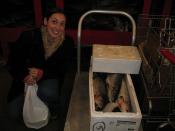Working-Class Fiction And The Women Who Write It This course analyzed the plight of the woman worker as portrayed in various works of writing. I define the working class as those that do not own the means of production. However, I also believe that there is a hierarchy within the working class that distinguishes between professionals and blue-collar laborers, or in other words, the wealthy working class from the poor working class. The works of fiction we studied have shown us the range of work that women have performed in order to sustain themselves and/or their families. Also, these works have shown us the variety of ways in which authors can describe the stories of these women and how they can artistically convey their experiences.
"Roselily"ÃÂ by Alice Walker was an unusual work because the setting was very unique. Walker wrote the story by sharing with us her main character's thoughts during her wedding.
This work consisted of flashbacks and future predictions in Roselily's mind. As the audience reads the main character's thoughts, there are interruptions in the text. Between Roselily's thoughts we are pulled back into her reality with a line of the ceremony recited by the preacher. This is how we as the audience were able to recognize that we were reading her thoughts in the middle of her getting married. Walker made predictions about what was to come in Roselily's future in Chicago with the intention of letting the reader know where the characters were going after the wedding.
Alice Munroe used symbolism in "How I Met My Husband"ÃÂ with the luxurious home and clothes that the family that she worked for had. These finer things represented the fact that working-class people can live in these environments only if they are hired to. Also, the...


